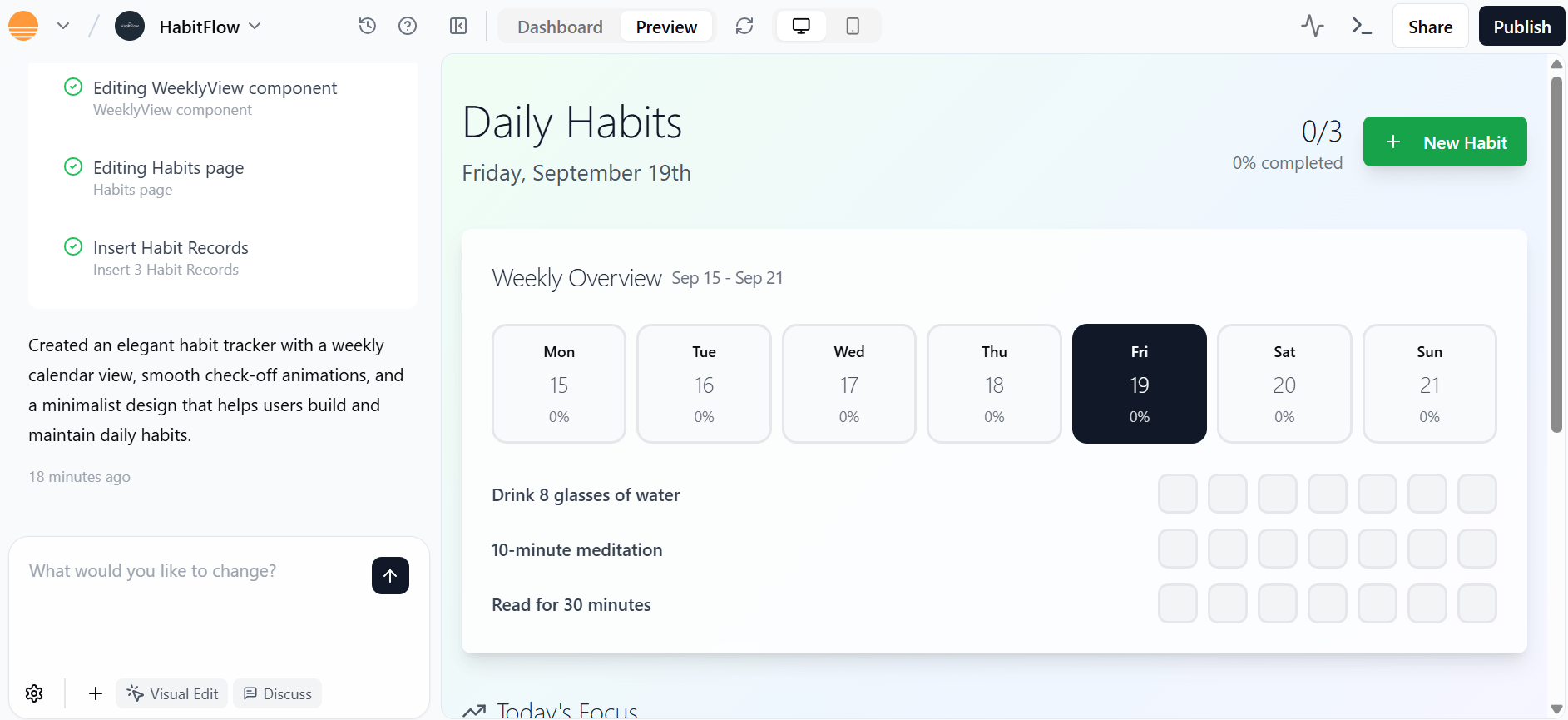You no longer have to be a coding whiz to bring your app idea to life. In fact, in 2025, AI and vibe coding platforms like Base44 will allow you to generate a fully-fledged app with just a single text prompt.
While traditional methods like native development are still very much in use, the barrier to entry for creating software has never been lower. All you need is a clear vision and a few minutes to describe it in plain English.
However, despite recent advances in AI, there’s no silver bullet when it comes to app development. So, to help you explore all available options, we cover four main ways you can build an app, unpacking their key benefits, drawbacks, and use cases.

How to Make an App: Summary
If you’re interested in building an app, there’s a method out there that’s able to fit your unique project and skill level. Here are the four main approaches to consider:
- Coding it yourself – The traditional method for maximum control, which requires the most technical know-how and time.
- Hiring someone to do it – The high-end option, which ensures high-quality custom results, but at a cost.
- Website-to-app converters – A quick and easy way to turn an existing website into an app, with a compromise of functionality.
- No-code apps – The modern, accessible method for building an app yourself, without writing a single line of code.
1. Code it Yourself
The most traditional method to bring your app to life is to code it yourself. This approach is the developer’s choice and involves using various programming languages — from Python to Java — to build an app from the ground up.
The upshot? By coding an app from scratch yourself, you have complete control over the user interface, user experience, and functionality of the app. You’re also not limited by the constraints of a pre-built platform. Choosing this approach allows you to build a complex and highly specialized application that wouldn’t be possible through other methods.
Using the DIY approach can be affordable, too. If you have the patience and passion to learn a new skill, coding an app yourself can save you tens of thousands of dollars, with some platforms letting you get started for completely free.
However, your time has value, and coding can be a very time-intensive task. The process requires you to wrap your head around coding, write thousands of lines of code, and troubleshoot bugs, and can take anywhere from two months to a year to complete.
While resources like Codecademy, Coursera, and freeCodeCamp can teach you the basics, you’ll also require a deep understanding of app architecture, security, and database management. This makes the method less suitable for those who lack the time and dedication to learn a complex skill, one that can take several years to properly master.
2. Hire an App Developer
If you want to create a highly specialized or complex app, but lack the time or expertise to execute it well yourself, you might want to consider hiring a professional. This approach involves outsourcing the entire app development process to a skilled third-party, whether it be a freelance developer or a dedicated agency.
Putting your project in the hands of a seasoned professional guarantees you a high-quality, bug-free product. It also helps you overcome the limitations of DIY app-builders, which currently struggle to create apps requiring sophisticated features like real-time location, tracking, and advanced machine learning.
Pursuing this option also allows you to drastically reduce your time to market, with a professional team taking roughly half the time to complete a moderately complex app, compared with an inexperienced beginner.
However, this convenience will cost you. Hiring a professional is by far the most expensive option to turn your idea into a reality, with costs ranging from tens of thousands of dollars to upwards of $150,000, depending on the app’s complexity. On an hourly basis, this can be $200+ for the services of a highly experienced developer.
You’ll also be omitted from day-to-day decisions about the technical design and code, forcing you to sacrifice some control or spend significant time feeding back on changes and adjustments.
If these sound like fair trade-offs, there are a few different avenues for finding talent. Websites like Upwork and Fiverr are great resources for finding freelance developers, while development agencies listed on sites like GoodFirms are better suited to support complex projects.
3. Website-to-App Converters
Website-to-app converters are automated platforms that let you transform existing websites into professional, ready-to-use mobile apps.
The process, which is also known as “hybrid app creation,” places your existing website inside a “shell” or “wrapper” that is itself a native application. This allows all of your branding and content to be passed on and also enables your product to be listed on app stores, like the Apple App Store and Google Play.
If you already have a pre-existing website, this is by far the quickest way to get an app on the market. In fact, platforms like Convertixo or Appy Pie can build functional apps within a matter of minutes or hours; all you need to do is enter your website’s URL. These services are often low-cost or free too, making it much more affordable than outsourcing.
However, the method is not always perfect. First of all, it’s only an option for those with existing websites. Secondly, most website-to-app converters provide limited access to device hardware, push notifications, GPS, or the camera, making the method a poor fit for apps that rely heavily on native phone features.
4. No-Code Apps
If you don’t have tons of time or technical abilities, nor a website to convert, no-code platforms are by far the most accessible method for building an app. As the name suggests, no-code apps let you create fully-functional apps without learning a lick of code.
Within this field, a powerful sub-genre has emerged: vibe coding. Pioneered by platforms like Base44, this method uses AI to create apps from natural language prompts. Working in a similar way to ChatGPT, the method takes care of every step of the process for you, from the UI to the backend. All you need is a clear idea of what you want to achieve.
The method is extremely quick and easy, especially compared with coding it yourself or outsourcing the task to a third party. Platforms like Base44 help you transform ideas into a live product within a couple of minutes, and they require virtually no learning curve to get started.
However, while vibe coding lets you refine your app with additional prompts, you don’t have the granular control that coding from scratch provides. You also might struggle to create highly specialized or large-scale applications using this method, as no-code methods tend to be less optimized for resource-intensive features. However, these nascent platforms are improving at a breakneck pace, so it may not be long before building complex applications becomes significantly easier.
The lack of control won’t be a dealbreaker for most, though. The accessibility and speed of no-coding options make them ideal for a wide range of projects, whether it be building app prototypes, internal business tools, or creative apps for personal projects.
What are the best vibe coding apps?
With vibe coding still in its infancy, it can be hard to know which platform is best to get started on. However, Base44 has already emerged as a clear leader of the pack, due to its prompt-first workflow and ability to generate full-stack applications.
Unlike many other vibe coding platforms, which require you to rely on third-party services to build things like databases and user authentication, Base44 handles all of these functions in-house. This allows you to build, manage, and complete a custom product without leaving its centralized dashboard.

Base44 let me create a Daily Habits app in a couple of minutes, by entering a natural language prompt. Source: Tech.co
Base44’s chat-based interface is also very easy to get started on. Instead of navigating drag-and-drop builders, all you need to do is type what you want into the chat window, making it ideal for users with little technical know-how who need a working app within a couple of minutes.

Base44 isn’t the only viable option out there, though. Lovable is another prompt-driven vibe coding app with a notably low learning curve, while v0 is more technically focused, positioning it well for developers with a complex vision and a little more coding expertise.
There also exists a range of free vibe coding platforms and plans you can check out if you want to explore the software yourself. Be warned though, they often have quite strict credit limits, which means you won’t be able to make many modifications to your creation.
The best method for building your app is ultimately going to depend on a lot of specifics about your business, including your current budget and the technical expertise you have on hand. Excitingly, however, the emergence of vibe coding apps means the barrier to entry, on both these fronts, has never been lower.
If you click on, sign up to a service through, or make a purchase through the links on our site, or use our quotes tool to receive custom pricing for your business needs, we may earn a referral fee from the supplier(s) of the technology you’re interested in. This helps Tech.co to provide free information and reviews, and carries no additional cost to you. Most importantly, it doesn’t affect our editorial impartiality. Ratings and rankings on Tech.co cannot be bought. Our reviews are based on objective research analysis. Rare exceptions to this will be marked clearly as a ‘sponsored’ table column, or explained by a full advertising disclosure on the page, in place of this one. Click to return to top of page